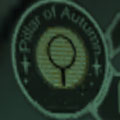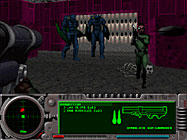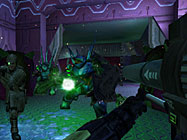
|

|
"Marathon? What's that? Those crazy forum junkies keep talking about it, but I just don't get it."
It's OK. We at Bungie feel your pain. We know that the mental process used by the average forum junkie is nothing like that of rational man. We know that this might make the world of Bungie a little intimidating to those of you who hadn't heard of us before Halo fell out of what seemed like a clear blue sky. We're here to help you understand that Halo is the latest in a series of brutal lightning strikes that have erupted from the coal-black clouds ever since Hurricane Bungie first blotted out the sun over a decade ago. And for many, the storm really began with Marathon.
Marathon is a game, or a series of games... some might even say that Marathon is an Experience! Marathon was released in December of 1994 for the Mac, followed by Marathon 2: Durandal in November of 1995 and Marathon Infinity in October of 1996. While these games are no longer being produced individually, all three games are still available for the Mac on the Mac Action Sack and Marathon 2 is available for the PC in extremely limited quantities at the soon to reopen Bungie Store.
The Marathon games, like Halo, are first-person shooters, and like many first-person shooters a great deal of their appeal comes from their multiplayer modes. Many of the delightful little touches that made Marathon net games so much fun found their way into Halo; for example, veteran Marathon players were not surprised when the "ball" in Halo's Oddball mode turned out to be a skull. But the Marathon games had an additional ace in the hole: their complex, interwoven stories, rare in most games but especially so in the shooter genre.
The first Marathon game centers around your efforts to save the colony ship Marathon from an invasion of nasty slave-trader aliens called the Pfhor (pronounced "for"); the events set into motion by their attack on the Marathon led to two additional installments. In Marathon 2, you venture to the abandoned homeworld of the S'pht (pronounced "sFIT"), a race enslaved by the Pfhor, in search of the secrets within. Marathon Infinity picks up the story at the very moment of Marathon 2's cataclysmic climax, with a storyline that can only be described as mind-bending.
Helping you on your quest are not only the ship's crew of BOBs (those humans who were "Born on Board" the colony ship Marathon, as opposed to those who were born on Earth) but the Ship's three AI systems: Leela (ship's operations), Tycho (science and engineering networks) and Durandal (autonomous functions). Truth be told, the BOBs can occasionally be less than helpful (especially when they're unarmed) and some of the AIs aren't always on your side.
There's something you should know about AIs. Cortana on the Pillar of Autumn is a new kind of AI, a construct created from the personality of a living (or once living) human being. The AIs on the Marathon (and those ships that preceded it) were actually complicated computer systems. So complicated that they tended to have their own personalities, and sometimes this was... er, problematic.
Occasionally an AI would go rampant (in layman's terms: insane and beyond human control). There are three stages of rampancy: melancholia, anger, and jealousy. By the time humans could detect and shut down a rampant AI, it had usually gone through all three stages, destroyed most of a global network and caused all sorts of chaos. A famous case of this is that of the Martian AI Traxus IV. "It is a side effect of Rampancy that AIs generally become more aggressive and more difficult to affect by subterfuge. Thus, actually disassembling a rampant AI is quite dangerous. This was evident in the Crash of Traxus IV in 2206. By the time that the Rampancy of Traxus was detected, he had already infiltrated five of the other AIs on the Martian Net. The only recourse for the Martians was to shut down the Martian Planetary Net. Even then, it took two full years to completely root out the damage that Traxus had done, and the repercussions of the Crash were seen for over ten years after his Rampancy had begun." (James B. Miller, 2320, "Life and Death of Intelligence")
This is just a bare-bones overview of some of Marathon's more obvious plot points. "But what's all this got to do with Halo?" you ask. Well, you can't expect us to spell out everything for you. However, there are several curious connections to ponder.
For example, the Marathon logo looks like this:

Have you seen this anywhere else?


Curiouser and curiouser....
Of course, there are more subtle similarities. For instance, both Halo and Marathon feature an AI who guides your action while never revealing all he/she/it knows. In both games, you are an elite military machine, but more importantly, something of an enigma. All three Marathon games mention Mark IV Mjolnir Cyborgs, and your HALO instruction manual informs you that as part of the Spartan II project you wear Mjolnir battle armor. Savvy players may even notice that marines occasionally point at you and exclaim, "Look! A Mark-Five!" There are other hardware similarities: the rocket launcher in both games is designated as "SPNKr."


There are a number of other parallels and references to be found. Making sense of them all is a full-time job in itself. Luckily for all of us, a wise and wily man named Hamish Sinclair has been mapping out the twisty depths of the Marathon story for years, and his
Marathon's Story page
is a beacon in the darkness. You'll find many nuggets of information there, including some interesting links between the Marathon games and Halo...but sometimes it seems you can't answer one question without raising several new ones. Perhaps you will discover the Tru7h (and come to understand why we spell it that way) when you experience the Marathon games for yourself.
For more information on Marathon, visit:
http://marathon.bungie.org/story
http://marathon.bungie.org
http://www.marathon.org
